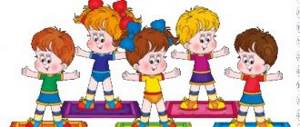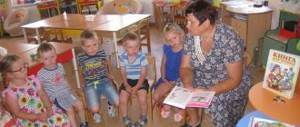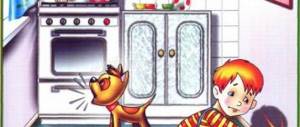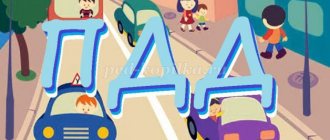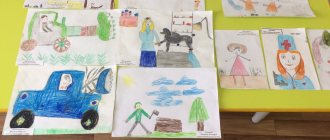Thematic week within the framework of the month “The path of your safety” Senior group 10. - presentation
Thematic week within the framework of the month “The Path of Your Safety” Senior group 10
Goal: To help children master basic skills of safe behavior at home, on the street, in transport; Teach children to act adequately and consciously in a given environment; Promote a safe, healthy lifestyle.
Action plan 1 day A child at home 2 day A child on the city streets 3 day Fire safety rules 4 day A child and the railway 5 day Rules of conduct with strangers
A child comes into this world for a long and happy life. This should be the case, but, unfortunately, it does not always happen. Starting to explore the world around him, a little person may encounter a lot of situations that directly or indirectly pose a threat to his health and even life. Therefore, the main task of adults is to instill in children a culture of safe behavior.
Safe behavior on the street, safe behavior at home, safe behavior with people - all these are components of a general safety culture. But if we constantly pull the child back and tell him that here you can get hit by a car, get burned there, get hurt here, nothing good will come of it. We will raise a frightened, helpless creature with a huge baggage of complexes. How to make sure that both adults are calm and children are safe? This will be helped by systematic preventive work with children, carried out in the most acceptable form of play for them, which is closely intertwined with the cognitive process.
All the poems from this book For girls and boys, Read this book and learn: How to behave when you are at home, How to communicate with a stranger, How to avoid a fire... In general, friend, hurry to know everything! G. P. Shalaeva, O. M. Zhuravleva “New rules of behavior for well-mannered children”
Examination of illustrations, albums, educational books
Household hazards Sharp, piercing and cutting objects Medicines and household chemicals Gas Window and balcony Electrical appliances
Game training “Dangerous objects in the house”
Game exercise “Show it correctly”
Joint drawing up of drawings - “reminders” Rules for handling electrical appliances
Board game – dominoes “Road Signs”
Consolidating traffic rules on the “City Streets” layout
Remember! Electrical appliances may cause electric shock or cause a fire. When leaving the house or even your room, be sure to turn off electrical appliances.
Every citizen must know - Fireman's phone number If something catches fire, Take the courage: Call 01 urgently, Give the exact address, What's on fire? How long ago? Where? A few minutes will rush by - the fire department will rush to you. And will help you in trouble.
Compiling stories “So that this doesn’t happen”
Be careful, Dear guys: Don't trust strangers!
Lotto "Safety Fundamentals"
Information sheet – safety coloring page
One of the main factors in successfully instilling safe behavior in children is the example of adults. Even a single wrong action in front of a child or together with him can negate all verbal instructions and warnings. Thank you for your attention! The presentation was compiled by the teacher of group 10 Akman T.I.
Calendar - thematic planning in the senior group on the topic “Parts of the body”
Theme "Parts of the body."
The content of the work:
Expanding ideas about health and important components of a healthy lifestyle (proper nutrition, movement, sleep) and factors that destroy health, fostering the desire to lead a healthy lifestyle. Developing ideas about the peculiarities of the functioning and integrity of the human body, teaching children to be attentive to their own health, to take into account the characteristics of their body and health (allergies, poor eyesight, etc.).
Formation of the ability to determine the quality of products based on sensory sensations. Formation of ideas about the rules of patient care, development of emotional responsiveness and sensitivity.
Final event
: Quiz “Get Healthy.”
Implementation period
: from October 28 to November 1.
28 of October. Monday.
Morning.
Conversation with children “A healthy mind in a healthy body.” To form the habit of a healthy lifestyle in children, to give an idea of the benefits of physical education for maintaining health.
Individual work with Camilla, Safia. Didactic game “Place in order.” Consolidate with children knowledge about the number segment within 5, practice comparing objects according to various criteria.
Work. Duty in a corner of nature - caring for indoor plants. Purpose: to give an idea of flower propagation (cuttings, shoots), to develop labor skills.
Independent play activities of children in employment centers.
OOD.
1. Speech therapy.
2. Cognitive development (familiarization with the environment).
Topic: "Parts of the body."
Integration: cognitive, speech development.
Goal: Formation of children’s ideas about the human structure, caring for their body
Tasks.
Correctional and educational:
To develop children’s ability to identify and correctly name parts of the body; find and correctly name fingers.
Correctional and developmental
:
Develop children’s ideas about themselves, their bodies, and activate dialogic speech; develop creative thinking, attention, imagination, fantasy, voluntary memory;
Correctional and educational
:
Develop the habit of a healthy lifestyle; the ability to listen to each other and adults; independence, confidence in one’s skills, accuracy; desire to help; the ability to express positive emotions from the results of activities.
Preliminary work: reading the story by K. I. Chukovsky “Doctor Aibolit”; laying out a series of pictures in a certain sequence; conversation about a healthy lifestyle; examination of illustrations, did. game "Dress the doll Masha."
Vocabulary: massage, little finger, index finger, ring finger.
Teaching aids: mirrors for each child, a poster depicting the structure of the human body, a ball, a comb, a presentation.
Walk
No. 1. Individual work with Leva, Mark.
2 half day
3. Physical development.
Theme: “Throwing the ball. Climbing under the arc. Walking with stepping."
Integration: physical, social and communicative development.
Goal: Developing the ability to maintain stable balance. Tasks.
Correctional and educational
Continue to practice the walking skill by changing the pace of movement at the teacher’s signal; running in all directions; develop coordination of movements and eye when throwing a ball at a target.
Correctional and developmental.
practice crawling under an arch while maintaining stable balance.
Correctional and educational
Cultivate endurance and the need for physical exercise.
Preliminary work. Ball games.
Equipment: Balls (diameter 6-8 cm) according to the number of children, 4-6 arcs, 6-8 medicine balls.
Reading fiction: K. Chukovsky “Doctor Aibolit.” Development of an emotional attitude towards the characters of a fairy tale, towards the work as a whole.
Develop the ability to listen to each other
Role-playing game "Polyclinic". Objectives: to develop the ability to independently assign roles, develop the plot based on personal experience, and use substitute objects in the game.
Walk
No. 2 Individual work with Matvey, Artem O.
.
Independent activity of children in the center of didactic games: “Mosaic”, “Puzzles”, “Loto”. Development of fine motor skills.
Individual conversations with parents “What kind of physical activity do children get at home?”
29th of October. Tuesday.
Morning.
Conversation “Sports and People”. Goal: consolidate knowledge about various sports, develop interest in various sports, and the desire to play sports.
Didactic game “Cleanliness is the key to health.” Develop cultural and hygienic skills.
Individual work with Katya and Ilya. D/i “It was – it will be.” Clarify children's ideas about the past, present, and future tense.
OOD
1. Speech therapy.
2.Cognitive development. FEMP
Topic “Numbers and figures 1,2, 3, 4, 5. Signs =, -. The month is October.”
Integration: cognitive, artistic and aesthetic development.
Goal: formation of the basic elements of cognitive activity.
Correctional educational tasks.
To develop children’s ability to solve a mathematical riddle, write down solutions to problems using signs and numbers, write the number 5, solve a logical problem to establish a discrepancy;
Fasten
the ability to write numbers 1,2,3,4, to understand the independence of numbers from the size and spatial arrangement of objects.
Meet
with the composition of the number 5 from two smaller numbers; with the name of the current month - October, with popular expressions that mention the number 5.
Corrective and developmental tasks
Promote the development of visual attention;
Continue to teach to understand the learning task and carry out
Develop logical thinking, imagination, fine motor skills.
Correctional and educational tasks
Develop the skills of self-control and self-esteem.
To cultivate independence, perseverance, the desire to bring the work started to completion
end.
Preliminary work: Board games with geometric shapes, work in copybooks, in checkered notebooks.
Vocabulary: October.
Learning aids: workbooks, colored and pencils
Walk
No. 3 Individual work with Arseny, Timur.
Afternoon
.
3. Artistic and aesthetic development. Music.
Didactic game “You can - you can’t.” Strengthen the foundations of a healthy lifestyle.
Printed board game “Collect a picture.” Exercise children in putting together a whole picture from individual parts. Develop visual perception.
Walk
No. 4. Individual work with Dasha, Marina.
Didactic game “Nature and Man”. To update and systematize children’s knowledge about what is made by man and what nature gives to man, to develop the ability to classify objects.
Riddles about the structure of the human body. Goal: develop memory and thinking.
October 30. Wednesday
Morning.
Conversation “How does our body work?” Summarize ideas about the structure of the human body and the functions of the sense organs.
Didactic game “Who knows more about themselves?” Strengthen knowledge about the human body.
Individual work with Diana, Azalea. D/i “Say it differently.” Strengthen the ability to select antonyms.
Work. Canteen duty. Strengthen the ability to properly set the table for breakfast.
OOD
.
1. Speech therapy.
2. Physical development.
The topic is “Game exercises “Pass each other”, “Relay race “Be nimble”.
Integration: physical, social and communicative development.
Goal: Developing the ability to maintain stable balance. Tasks.
Correctional and educational
Exercise children in walking and running while stepping over obstacles; continuous running for up to 2 minutes; teach badminton; practice passing the ball with your feet (elements of football) to each other; repeat the game exercise with jumping.
Correctional and developmental.
Develop agility, jumping, endurance, reaction speed.
Correctional and educational
Cultivate endurance and the need for physical exercise.
Preliminary work. Ball games.
Equipment: several balls (diameter 20-25 cm), 5-6 short cords, 6-8 bars, rackets and shuttlecocks for playing badminton.
Walk
No. 5. Individual work with Vanya, Alena.
2 half day.
3. Artistic creativity. Drawing.
Theme "My mood".
Integration:
artistic and aesthetic development, cognitive development, speech development.
Target:
Formation of interest in portraiture as one of the genres of fine art.
Tasks.
Correctional educational
. Improve technical skills in depicting a person’s face; to develop communication skills, introduce the concept of “self-portrait”, consolidate the concepts of “portrait”, “single portrait”, “group portrait”.
Correctional and developmental
: develop the ability to notice similarities with oneself, shown in facial expressions, in the expression and color of the eyes, in the manner of dressing; develop figurative perception, visual memory.
Correctional and educational
: cultivate accuracy in working with watercolors, interest in painting.
Dictionary:
portrait, self-portrait.
Teaching aids: portraits of people, sheets of paper, simple and colored pencils, paints, jars of water.
Retelling the story “What are hands for” (E. Permyak) - to develop children’s speech, to develop the ability to clearly answer questions posed.
"Rules of hygiene."
Goal: To consolidate children's knowledge of the names of toiletries and the names of body parts. Learn to select adjectives and verbs for each noun on a given topic, coordinate nouns with possessive pronouns (my, yours, ours) in gender and number.
Walk
No. 6 Individual work with Danil, Ilnaz.
Didactic game “Show me where it is?”, “I made a wish”, “What for what?”. To consolidate an understanding of the human body and develop logical thinking.
Independent play activities of children in employment centers. Consultation for parents “A healthy mind in a healthy body.”
October 31. Thursday.
Morning.
Conversation with children “We are friends with physical education.” To consolidate the concept of the benefits of physical education and sports for human health.
Didactic game “What they teach at school.” Continue to train children in the ability to compose and solve arithmetic problems using a clear example.
Individual work with Arthur, Emil. Didactic game “Good - bad”. Develop logical thinking.
Independent activity of children in the area of visual activity: work in coloring books.
OOD
1 Artistic and aesthetic development (sculpting)
Topic: “Merry men”
Integration: artistic and aesthetic development, social and communicative development.
Goal: To develop the ability to sculpt a human figurine.
Tasks:
Correctional and educational
:
Improve the ability to roll with your arms in a vertical position. Teach the child to work consistently with both hands, to measure the pressure of the palms on the plasticine.
To develop the ability to sculpt human figures in a rational way from an elongated cylinder (roller), to understand the relativity of the size of parts, to position the craft vertically, giving it stability. Show the possibility of conveying the movement of a molded figurine by slightly changing the position of the arms and legs.
Correctional and developmental
:
Develop fine motor skills, imagination, coordination of movements.
Develop the ability to see and characterize the individual characteristics of crafts.
Correctional and educational
:
Cultivate respect for working people
Cultivate an interest in fine arts.
Cultivate independence and accuracy.
Preliminary work: examining the human figure.
Dictionary: smearing.
Teaching aids: dolls, plasticine, stacks, boards, paper or cloth napkins.
2. Artistic and aesthetic development. Music.
Walk
No. 6 Individual work with Artem Yu., Vanya.
2 half day
Didactic game "Ear, nose, hand." Goal: development of attention, reaction speed.
“Kaleidoscope of Emotions” - work with pictures and photographs depicting emotions.
Continue to develop the ability to determine mood and emotions by facial expressions.
Reading the story “Childhood Friend” by V. Dragunsky. Goal: to develop children’s ability to emotionally perceive the figurative content of the work.
Walk
No. 2 (repetition) Ind. work with Arseny.
Sedentary game “What the hands can do” - to develop memory and reaction speed, throwing accuracy and dexterity when receiving the ball, to develop honesty when following the rules of the game.
Board game "Body Parts". Activate children's vocabulary.
Nov. 1. Friday.
Morning.
Conversation with children “Health is the main wealth.” Reinforce the idea of the need to take care of your health.
Didactic game "Professions". To consolidate ideas about people’s professions related to improving people’s health.
Duty in a corner of nature - offer to wipe the dust on large leaves of plants. To develop the ability and desire to care for flowers.
Individual work on FEMP. Didactic game “Make an object from triangles” (Ilnaz, Dasha). Develop the ability to create a structure of four isosceles triangles, navigate on a sheet of paper, and name the direction in words: left, right, top, bottom.
OOD
1. Speech therapy.
2. Artistic creativity. Drawing.
Topic: "Doll"
Integration: artistic and aesthetic development, social and communicative development.
Goal: Develop a sense of form, aesthetic perception
Tasks:
Correctional and educational:
To develop children’s ability to convey in a drawing the image of a doll in a dress.
Strengthen the ability to depict the shape of parts of a human figure, their relative size, location.
Continue to develop the ability to draw large,
in the entire sheet.
Strengthen the ability to draw and paint over drawings with pencils ,
hold the pencil correctly.
To develop the ability to note the beauty of created images: a beautiful uniform, an elegant dress, all dolls are different, each has their own.
Strengthen the ability to convey shape, convey in a drawing the location of parts of a human figure, their relative size, practice drawing and painting
Correctional and developmental
:
To develop aesthetic perception in children,
Develop fine motor skills.
Correctional and educational
:
Arouse interest in drawing and a desire to draw a doll, a feeling of joy from the images they create.
Cultivate accuracy in working with gouache and watercolor. Make you want to admire your work.
Encourage the desire to look at finished drawings and choose the most interesting ones.
Preliminary work. Look at the doll with the children. To say that the doll is beautiful, pay attention to the shape and size of the parts, their location.
Vocabulary: wrists, elbows, ankles, earlobes, eyebrows, cheekbones, and temples.
Teaching aids: sheets of paper, pencils and colored pencils
Walk
No. 7. Individual work with Azalea, Marina.
2 half day.
3.Physical development
Theme: “Throwing the ball. Climbing under the arc. Walking with stepping."
Integration: physical, social and communicative development.
Goal: Developing the ability to maintain stable balance. Tasks.
Correctional and educational
Continue to practice the walking skill by changing the pace of movement at the teacher’s signal; running in all directions; develop coordination of movements and eye when throwing a ball at a target.
Correctional and developmental.
practice crawling under an arch while maintaining stable balance.
Correctional and educational
Cultivate endurance and the need for physical exercise.
Preliminary work. Ball games.
Equipment: Balls (diameter 6-8 cm) according to the number of children, 4-6 arcs, 6-8 medicine balls.
Conversation “What can skin do?” Goal: to introduce children to the purpose and properties of skin, teach children to treat minor wounds, explain the purpose of iodine and brilliant green, and cultivate a desire to observe the rules of personal hygiene.
Final event: “Get Healthy” Quiz.
Didactic game “Flower-seven-colored”. To develop children’s ability to express their wishes.
Walk
No. 1 (repetition). Individual work with Katya and Matvey.
Didactic game “When does this happen?”
Objectives: to consolidate children’s knowledge about the seasons, seasonal changes, to activate relevant concepts in speech, to teach them to coordinate nouns and adjectives.
Outdoor game. “Find where it’s hidden?” - develop spatial orientation in children, cultivate endurance, observation, and honesty.
